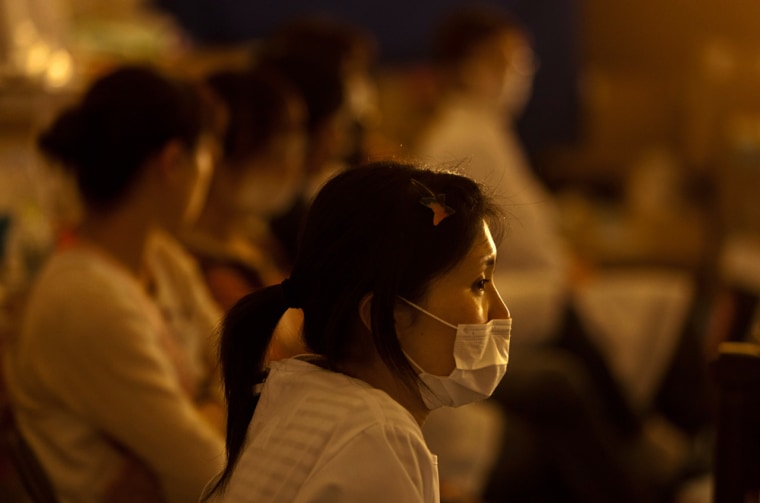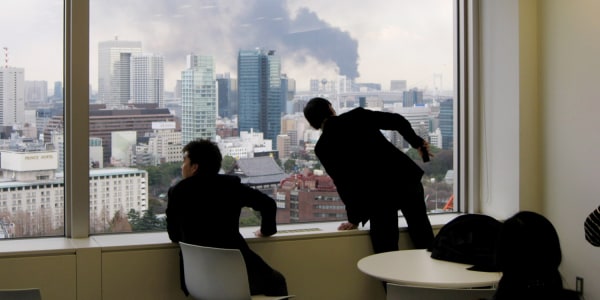Authorities were considering restricting access to the evacuation zone around Japan's crippled nuclear plant Wednesday to limit radiation exposure to residents who may want to return to their homes.
"We are considering setting up 'caution areas' as an option for effectively limiting entry" to the zone, Chief Cabinet Secretary Yukio Edano said.
It was unclear when the ban might be imposed.
About 70,000-80,000 people were living in the 10 towns and villages within 12 miles (20 kilometers) of the Fukushima Dai-ichi plant, which has been leaking radiation after a March 11 earthquake and tsunami wrecked its power and cooling systems.
Tokyo Electric Power Co., the nuclear plant's operator, has begun pumping highly radioactive water from the basement of one of its turbine buildings to a makeshift storage area in a crucial step toward enabling work on restoring the cooling systems.
Removal of the 25,000 metric tons (about 6.6 million gallons) of contaminated water that has collected just in the basement of the turbine building at Unit 2 of the plant is expected to take at least 20 days, nuclear safety officials say. Fully ridding the plant of 70,000 tons (about 18.5 million gallons) of contaminated water in its turbine buildings and nearby trenches could take months.
Still, a senior official at the U.N. nuclear agency suggested the worst of the radiation leaks may be over in the worst nuclear power accident since the 1986 catastrophe in Chernobyl.
The total amount of radiation released is expected to be only a "small increase from what it is today" if "things go as foreseen," said Dennis Flory, a deputy director general at the International Atomic Energy Agency in Vienna.
Slideshow 46 photos
Triple tragedy for Japan
IAEA experts are discussing ways to help Japan meet targets laid out in a blueprint for ending the crisis that TEPCO released over the weekend. Its plans call for achieving a cold shutdown of the plant within nine months. But government officials acknowledge that setbacks could slow the timeline.
In the meantime, TEPCO is continuing to spray water into the reactors and their spent fuel storage pools to help prevent them from overheating and releasing still more radiation.
TEPCO plans to use technology developed by French nuclear engineering giant Areva to reduce radioactivity and remove salt from the contaminated water inside the plant so that it can be reused to cool the reactors, said Hidehiko Nishiyama of Japan's Nuclear and Industrial Safety Agency.
This process would take "several months," he said.
TEPCO said Wednesday it has begun distributing applications for compensation to residents forced to evacuate from their homes around the plant. The company is offering about $12,000 per household as interim compensation.
People elsewhere in the disaster zone who lost houses to the tsunami and quake — which also left more than 27,000 dead or missing — say help has been slow to materialize.
The government is still considering ways to limit access to the immediate vicinity of the nuclear plant while also responding to demands from residents, many of whom took practically nothing with them, to return to collect belongings, said Noriyuki Shikata, deputy chief Cabinet secretary for Prime Minister's office.
"We are considering ways for them to realize a short visit back to their homes," Shikata said.
"Both the issue of ... strong enforcement of the area and a realization of temporarily going back home is something we have to closely coordinate with local municipalities," he said, noting that for now there is no penalty for entering the area.
"There are also issues surrounding non-residents who are entering the area. There are people who may steal things. There are various issues involved," he said.
The disasters aretaking their toll on the economy.
Japan's exports in March fell for the first time in 16 months, the government said Wednesday.
Auto exports especially took a beating in the month as the twin disasters forced Toyota, Honda and Nissan to suspend their all Japanese production due to shortages of components.
Toyota Motor Corp. said Tuesday it will cut production at its plants in China due to supply chain disruptions.
In a statement posted on its Chinese website, Toyota said production at plants producing cars will run at half of its normal capacity until June 3.

